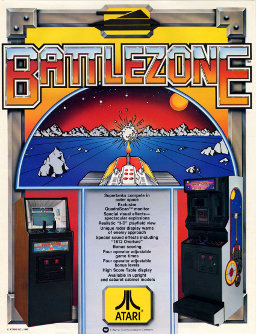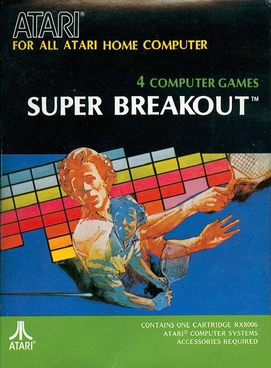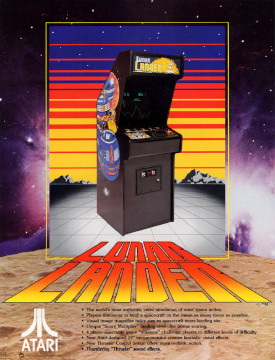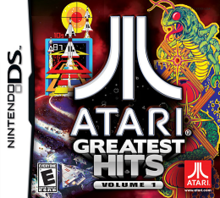
Asteroids is a space-themed multidirectional shooter arcade video game designed by Lyle Rains and Ed Logg released in November 1979 by Atari, Inc. The player controls a single spaceship in an asteroid field which is periodically traversed by flying saucers. The object of the game is to shoot and destroy the asteroids and saucers, while not colliding with either, or being hit by the saucers' counter-fire. The game becomes harder as the number of asteroids increases.

Millipede is a fixed shooter video game released in arcades by Atari, Inc. in 1982. The sequel to 1981's Centipede, it has more gameplay variety and a wider array of insects than the original. The objective is to score as many points as possible by destroying all segments of the millipede as it moves toward the bottom of the screen, as well as eliminating or avoiding other enemies. The game is played with a trackball and a single fire button which can be held down for rapid-fire.

Centipede is a 1981 fixed shooter arcade video game developed and published by Atari, Inc. Designed by Dona Bailey and Ed Logg, it was one of the most commercially successful games from the golden age of arcade video games and one of the first with a significant female player base. The primary objective is to shoot all the segments of a centipede that winds down the playing field. An arcade sequel, Millipede, followed in 1982.

Battlezone is a first-person shooter tank combat game released for arcades in November 1980 by Atari, Inc. The player controls a tank which is attacked by other tanks and missiles. Using a small radar scanner along with the terrain window, the player can locate enemies and obstacles around them in the barren landscape. Its innovative use of 3D graphics made it a huge hit, with approximately 15,000 cabinets sold.

Breakout is an arcade video game developed and published by Atari, Inc. and released on May 13, 1976. It was designed by Steve Wozniak, based on conceptualization from Nolan Bushnell and Steve Bristow, who were influenced by the seminal 1972 Atari arcade game Pong. In Breakout, a layer of bricks lines the top third of the screen and the goal is to destroy them all by repeatedly bouncing a ball off a paddle into them. The arcade game was released in Japan by Namco. Breakout was a worldwide commercial success, among the top five highest-grossing arcade video games of 1976 in both the United States and Japan and then among the top three highest-grossing arcade video games of 1977 in the US and Japan. The 1978 Atari VCS port uses color graphics instead of a monochrome screen with colored overlay.

George Edward "Ed" Logg is a retired American arcade video game designer, first employed at Atari, Inc. and later at Atari Games. He currently resides in Los Altos, California. He was educated at University of California, Berkeley and also attended Stanford University.
In video game parlance, a multicart is a cartridge that contains more than one game. Typically, the separate games are available individually for purchase or were previously available individually. For this reason, collections, anthologies, and compilations are considered multicarts. The desirability of the multicart to consumers is that it provides better value, greater convenience, and more portability than the separate games would provide. The advantage to developers is that it allows two or more smaller games to be sold together for the price of one larger game, and provides an opportunity to repackage and sell older games one more time, often with little or no changes.

Gravitar is a color vector graphics multidirectional shooter arcade video game released by Atari, Inc. in 1982. Using the same "rotate-and-thrust" controls as Asteroids and Space Duel, the game was known for its high level of difficulty. It was the first of over twenty games Mike Hally designed and produced for Atari. The main programmer was Rich Adam and the cabinet art was designed by Brad Chaboya. Over 5,427 cabinets were produced. An Atari 2600 version by Dan Hitchens was published by Atari in 1983.

The Atari Flashback series are a line of dedicated video game consoles designed, produced, published and marketed by AtGames under license from Atari SA. The Flashback consoles are "plug-and-play" versions of the Atari 2600 console. They contain built-in games rather than using the ROM cartridges utilized by the 2600. Most of the games are classics that were previously released for the 2600, although some Flashback consoles include previously unreleased prototype games as well.

Atari: 80 Classic Games in One!, known as Atari Anthology on consoles, is a video game collection developed by Digital Eclipse and published by Atari Interactive. The title is a compilation of 80 video games previously published by Atari, Inc. and Atari Corporation, reproducing Atari's games from its arcade and Atari 2600 game console platforms. Many games permit one to play each title at varying speeds, with time limits, or with a shifting color palette.

Super Breakout is a sequel to the 1976 video game Breakout released in arcades in September 1978 by Atari, Inc. It was written by Ed Rotberg. The game uses the same mechanics as Breakout, but allows the selection of three distinct game modes via a knob on the cabinet—two of which involve multiple, simultaneous balls in play. Both the original and sequel are in black and white with monitor overlays to add color. It was distributed in Japan by Namco and Esco Trading.

Atari Anniversary Edition is a video-game compilation of Atari arcade games. It was developed by Digital Eclipse and published by Infogrames.

Arcade's Greatest Hits: The Atari Collection 1 is a compilation of Atari arcade games for the Sega Saturn, PlayStation, and Super Nintendo Entertainment System. It is a successor volume to Williams Arcade's Greatest Hits. Most of these games fall into the action game category. The Saturn and PlayStation versions of the game include an FMV documentary on the "Golden Age of Atari", featuring video interviews with the programmers behind the six games in the compilation. The later Super NES version was announced by Midway as their final release for any "16-bit" console.

Lunar Lander is a single-player arcade game in the Lunar Lander subgenre. It was developed by Atari, Inc. and released in August 1979. It was the most popular version to date of the "Lunar Lander" concept, surpassing the prior Moonlander (1973) and numerous text-based games, and most later iterations of the concept are based on this Atari version.
Telegames, Inc. is an American video game company based in Mabank, Texas, with a sister operation based in England.

Retro Atari Classics is a collection of Atari video games for the Nintendo DS developed by American studio Taniko and released in 2005 by Atari. The game features classic Atari games as well as remixed versions of each of the selections. The game's development faced challenges of working with the then-changing prototype Nintendo DS hardware. The game received mixed reviews from critics.
Patrick Buckland is a British video game programmer, designer and chief executive officer of Stainless Games, which he co-founded with Neil Barnden in 1994.

Atari Vault is a collection of one hundred video games that Atari had produced for arcade cabinets and its Atari 2600 home console system, dating from the 1970s, 1980s, and 1990s. The collection was developed by Code Mystics, who had helmed similar collections of Atari games to other platforms, to work on Microsoft Windows, macOS, and Linux via the Steam client. The games, where possible, have been updated to include modern-day features such as local and online multiplayer and online leaderboards.

Arcade Classic is a series of five compilations of arcade games for Game Boy released in 1995. The first four were published by Nintendo, while the fifth was developed and published by Black Pearl Software. Each cartridge includes two games.

Atari 50 is a video game compilation and interactive documentary about the history of Atari. It comprises newly shot interviews with former Atari employees, archival footage, emulated games from the company's catalog, and six new games inspired by past Atari games. It was developed by Digital Eclipse and released on Atari VCS, Nintendo Switch, PlayStation 4, PlayStation 5, Windows, Xbox One, and Xbox Series X/S in 2022, the 50th anniversary of Atari's founding. The main feature of the game is a four-part interactive timeline that lays out the history of the company and its products through, video, scanned artifacts and related games.

















